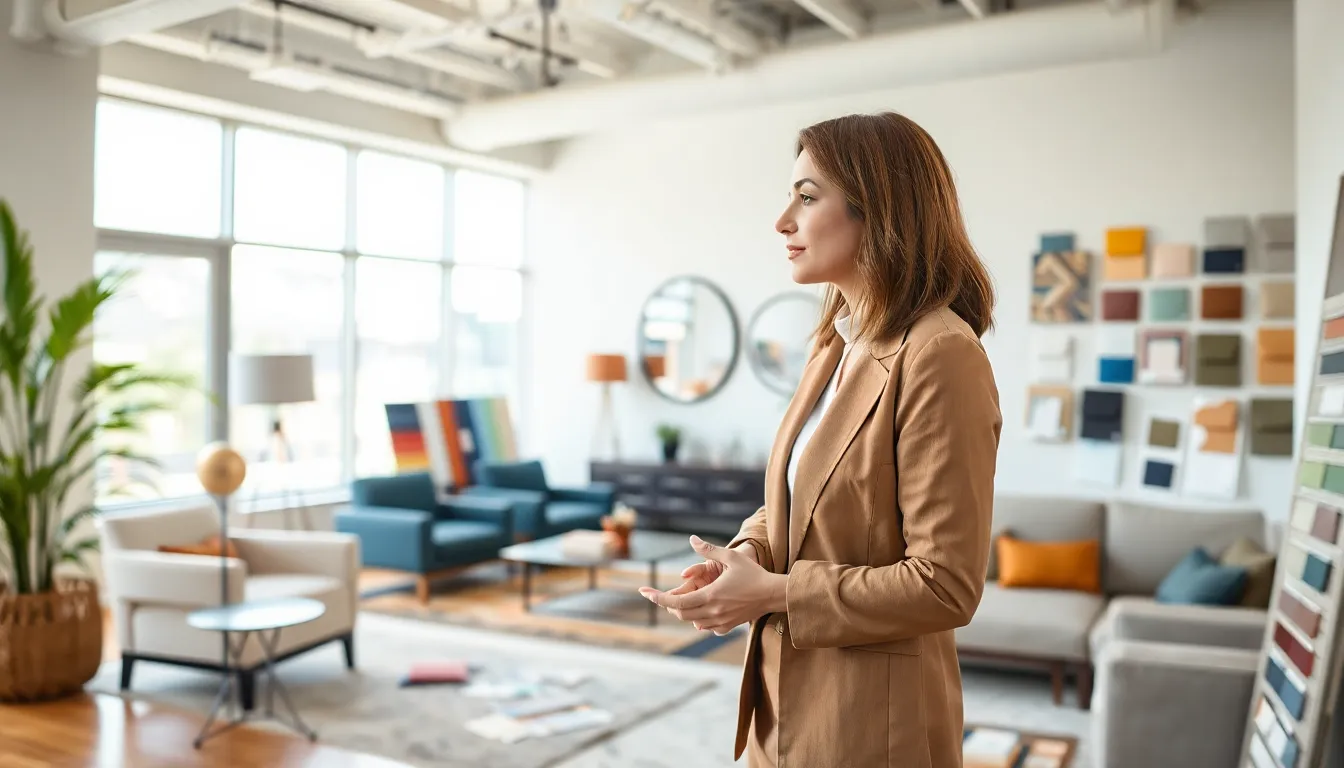
Interior Design Process: Unlocking the Secrets to Transforming Your Space
Transforming a space isn’t just about slapping a fresh coat of paint on the walls or arranging furniture like a game of Tetris. The interior design process is an art form that blends creativity with strategy, turning drab into fab. Whether it’s a cozy nook or a sprawling office, the journey from concept to completion can be as thrilling as finding that perfect pair of shoes on sale.
Interior Design Process
The interior design process involves a series of methodical steps that result in a thoughtfully curated space. Each stage plays a significant role in transforming ideas into a functional environment.
Stages of the Design Process
- Research: Gathering information about the client’s needs, preferences, and the space’s constraints.
- Concept Development: Creating initial design concepts, including color palettes, materials, and layouts.
- Schematic Design: Developing floor plans and views that represent design concepts graphically.
- Design Development: Refining the design by selecting furnishings, fixtures, and materials.
- Implementation: Overseeing the installation, ensuring that everything aligns with the design plan.
- Evaluation: Assessing the finished project and addressing any necessary adjustments.
Importance of Each Stage
Research establishes a foundation for understanding client requirements, leading to relevant design choices. Concept development fosters creativity while aligning with practical expectations. Schematic design visualizes ideas, helping clients envision the final outcome. Design development narrows down selections, ensuring aesthetic appeal and functionality coexist. Implementation brings plans to life, transforming blueprints into real spaces. Evaluation offers insights into the success of the project and allows for enhancements where needed.
Research and Planning

Research and planning serve as foundational steps in the interior design process, ensuring a successful transformation of any space. These stages prioritize understanding both the practical and creative aspects of design.
Identifying Client Needs
Clients communicate specific requirements that guide the entire project. Understanding their lifestyle, preferences, and functionality is crucial for tailored solutions. Questions about budget, timeline, and aesthetic preferences lead to a well-rounded perspective. Designers often conduct interviews or questionnaires to gather this information effectively. Analyzing feedback helps clarify priorities, setting a clear direction for the design process. Creating user profiles can further illustrate how different spaces will cater to individual needs.
Gathering Inspiration
Inspiration fuels creativity in the design process. Designers explore various sources, such as magazines, websites, and social media platforms, to spark ideas. Imagery from platforms like Pinterest or Houzz showcases design trends and elements that resonate with clients. Visual collages can help synthesize these inspirations into a coherent theme. Consideration of color schemes, furniture styles, and layouts emerges through this exploration. Discussing inspirational sources with clients ensures alignment between their vision and the designer’s concepts. Ultimately, gathering inspiration lays the groundwork for innovative design solutions.
Concept Development
Concept development plays a vital role in the interior design process. This stage bridges initial research with tangible design elements, ensuring clarity and coherence in the envisioned space.
Creating Mood Boards
Creating mood boards serves as an essential method to visualize design concepts. Designers gather images, color swatches, textures, and materials, organizing them on a board. This visual representation captures the desired atmosphere and style, allowing clients to understand and engage with the concept better. Mood boards enable collaboration by offering a reference point for discussions. By refining design choices visually, mood boards streamline decision-making, ensuring alignment with the client’s vision.
Sketching Initial Ideas
Sketching initial ideas provides a practical approach to translating concepts into designs. Designs begin with rough sketches that outline spatial arrangement and furniture placement. These initial drawings help identify potential layout challenges early, fostering creativity. Designers explore various configurations, ensuring client needs remain at the forefront. Each sketch advances a specific idea, allowing for experimentation with aesthetics and functionality. By developing multiple sketches, designers create a diverse range of possibilities to discuss with clients, ultimately guiding them toward the best solution for their space.
Design Development
Design development refines the initial concepts, ensuring practicality and style align with the client’s vision. This stage focuses on selecting materials, colors, and floor plans that enhance the overall design.
Selecting Materials and Colors
Choosing the right materials and colors plays a crucial role in achieving the desired aesthetic. Designers consider various texture options, such as wood, metal, and fabric, to create a harmonious environment. Colors also form essential elements; palettes might range from calming neutrals to vibrant hues. Samples of fabrics and finishes help clients visualize their space effectively. Designers often propose eco-friendly options, incorporating sustainable materials to promote wellness in the environment. This selection process invites collaboration, allowing clients to express their preferences and enabling designers to turn concepts into cohesive atmospheres.
Drafting Floor Plans
Creating detailed floor plans establishes a functional layout that accommodates the client’s needs. Designers assess space dimensions and shape, ensuring efficient use of the available area. Zones for specific activities, such as relaxation, work, or socializing, receive careful consideration. They often sketch multiple layouts with alternative furniture arrangements to explore optimal configurations. Innovative technology tools, like CAD software, enhance precision and clarity in plans. Collaboration with clients during this phase invites feedback, emphasizing their comfort with the proposed designs. Clarity emerges, allowing the project to transition smoothly into implementation.
Implementation
The implementation phase is where design concepts come to life through collaboration and skilled execution. This stage involves working closely with contractors to ensure accuracy in transforming ideas into reality.
Working with Contractors
Effective communication with contractors plays a vital role during implementation. Designers share detailed plans and specifications, ensuring understanding of the project’s vision. The selection of qualified contractors affects the project’s quality, so it’s essential to vet potential partners for their experience and expertise. Clear timelines and budgets establish expectations, facilitating a smoother workflow. Regular check-ins enable designers to address questions or concerns promptly. Collaborating effectively with contractors helps maintain the design integrity throughout the process.
Overseeing the Installation
Installation management is crucial for ensuring the project aligns with the initial design. Designers oversee every detail during installation to guarantee accuracy in implementation. Attention to finishing touches, such as furniture placement and decor arrangement, enhances the overall aesthetic. Coordinating with various tradespeople, such as electricians and carpenters, ensures every aspect performs as intended. Adjustments may take place to adapt to on-site conditions while remaining aligned with the design vision. Successful oversight culminates in a cohesive and functional space that meets the client’s expectations.
Finalizing the Project
Finalizing the project involves a series of critical steps that ensure the design aligns with client expectations and vision.
Client Walk-Through
Client walk-throughs serve as an essential part of the final phase. They allow designers to present the completed space to the client. During this process, clients see how their preferences were integrated into the design. Walking through each room, clients can evaluate the functionality and aesthetics first-hand. Observations made during the walk-through often lead to valuable feedback. Designers encourage dialogue to address any immediate questions or concerns. This interaction fosters satisfaction and reinforces the collaborative spirit of the design process.
Making Adjustments
Making adjustments often occurs based on client feedback during the walk-through. Small changes might enhance overall functionality or visual appeal. Designers remain flexible to accommodate any last-minute requests, identifying areas needing improvement. Adjustments can include rearranging furniture or choosing different decorative elements. Effective communication ensures that clients feel their input is valued. Keeping open lines of dialogue helps solidify relationships and enhances client satisfaction. Ultimately, these modifications contribute to a final result that meets or exceeds the client’s expectations.
Conclusion
The interior design process is a comprehensive journey that marries creativity with strategic planning. Each stage from research to final evaluation plays a vital role in crafting spaces that resonate with clients’ needs and aspirations. By understanding the nuances of each phase designers can transform environments into functional and aesthetically pleasing havens.
Successful interior design hinges on effective communication and collaboration. Designers must remain adaptable to client feedback and on-site realities. This flexibility not only enhances the final outcome but also fosters lasting relationships built on trust and satisfaction. Ultimately a well-executed design process elevates spaces and enriches the lives of those who inhabit them.
